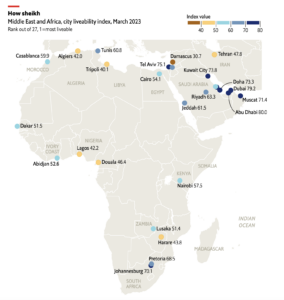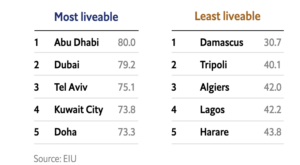August 1st, 2023
Via The Economist, a report on how cities in the Middle East and Africa currently remain at the bottom of EIU’s liveability index, but their scores are going up:
Egypt’s government worries that its citizens may get trapped in their lifts. Frequent power outages in Cairo, the capital, during the sweltering summer months mean that such miserable confinement is not an unlikely occurrence. Like many other cities in the Middle East and Africa, Cairo’s wobbly infrastructure makes it a difficult place to live. Food inflation is running at 66%, and members of the middle class are sliding into poverty. That reality is reflected in findings by eiu, our sister company, and its liveable cities index. See where Cairo and other cities in the Middle East and Africa ranked in our map below.
EIU’s global index judges 173 cities on five categories: stability, health care, culture and environment, education, and infrastructure. Notably, some big cities like Khartoum, in Sudan, and Baghdad, in Iraq, are not included in the index. Despite the general low rankings of cities in the Middle East and north Africa, liveability is generally improving. Its cities received an average score of 61, up from 58 last year. The score for sub-Saharan Africa (the world’s least liveable region) rose from 50 last year to 54 in 2023. Both regions saw improvements in cities at the bottom of the rankings. Algiers and Lagos—both in energy-exporting countries—benefited from rising energy prices, allowing their governments to pump money into public services and infrastructure.
Abu Dhabi retained its top spot in the region, thanks to good scores for its infrastructure and stability. Dubai, another city in the United Arab Emirates, was a close second. Tel Aviv in Israel, once a beacon of democracy in the region, came third. But its score was dragged down by increased instability—in large part because of unrest spurred by the government’s bid to limit the powers of the country’s independent judiciary.
There were other notable shifts across the Middle East and north Africa. Several cities in Saudi Arabia improved their score in the culture and environment category, which measures such things as the availability of sporting and cultural offerings. In culture, Saudi Arabia once lagged behind the likes of Cairo and Casablanca. Now it is trying to establish itself as the region’s media hub, pumping money into home-grown films and lavish music concerts. Even more notable is its foray into sports: it has acquired several European footballers to play in its domestic league, including Cristiano Ronaldo in late 2022. In June of this year it reportedly invested $3bn to merge its upstart golf tournament with America’s pga Tour and Europe’s dp World Tour, the biggest in the sport. But Saudi’s stability scores remained unchanged. Its rulers continue to stifle any opposition.
As in the past several years, war-ravaged Damascus, Syria’s capital, scored the lowest of any city in the world. Although Bashar al-Assad, the country’s brutal dictator, is no longer a pariah in the Middle East, his gradual return to the international stage has not led to any improvements in the living standards of his people. It is not likely that will change anytime soon.
Cities in sub-Saharan Africa didn’t fare so well either. Johannesburg, South Africa’s biggest city, is still the most liveable place on the continent south of the Sahara, but it dropped seven places in the rankings. (Cape Town, the country’s much-improved second city, is not part of the index.) The public sector there is failing: those with the means pay for private alternatives. Blackouts are more frequent there than they were last year. Its residents probably worry about getting stuck in a lift even more than Cairenes.
Focusing primarily on The New Seven Sisters - the largely state owned petroleum companies from the emerging world that have become key players in the oil & gas industry as identified by Carola Hoyos, Chief Energy Correspondent for The Financial Times - but spanning other nascent opportunities around the globe that may hold potential in the years ahead, Wildcats & Black Sheep is a place for the adventurous to contemplate & evaluate the emerging markets of tomorrow.


